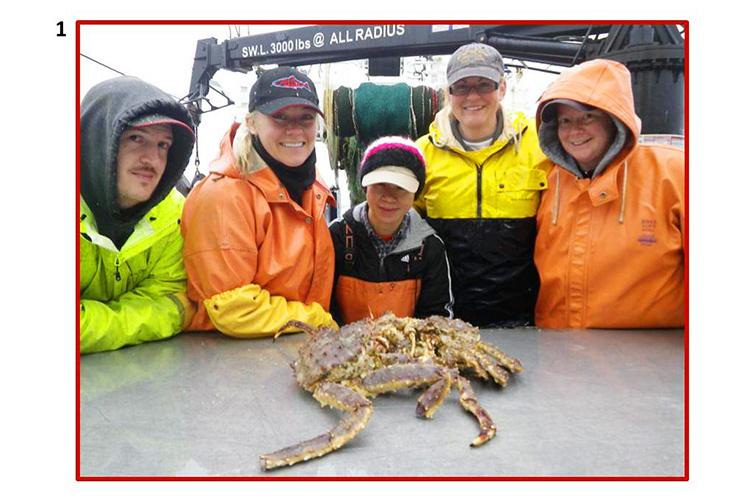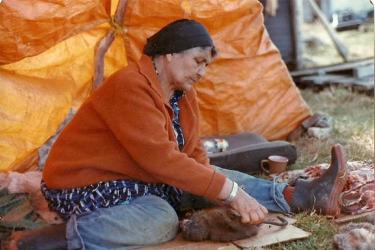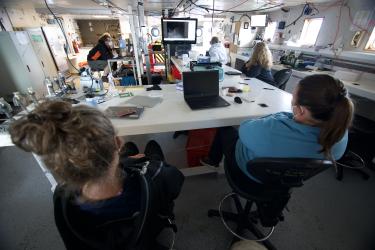Survey crew examines grasping pair of king crabs. From L-R: Chris Clarke, International Pacific Halibut Commission; Vanessa Lowe, Contractor; Cynthia Yeung, Alaska Fisheries Science Center; Miranda Wesphal, Alaska Department of Fish and Game; and Kaitlin Rogers, Northeast Fisheries Science Center.
The Season for Hugging Crabs
We caught something exciting the other day - a male red king crab tightly grasping a female (Pictures 1 & 2). Crab biologists Vanessa Lowe and Miranda Westphal tried separating the two to no avail. This may seem like caveman behavior on the part of the male crab, but it’s actually a vital part of this species’ mating cycle.
This Bering Sea love story goes something like this: Ms. Crab releases a perfume, or “pheromone,” into the water when she is getting ready to molt (shed her old and sometimes barnacle-encrusted shell). Ms. Crab’s pheromone is simply irresistible to Mr. Crab, who follows the trail, searching for Ms. Crab. Once he finds his love beneath the waves, they get “hitched” as he grasps her front legs with his claws. He holds on to her for about 2 weeks. Over this time, Ms. Crab increases in size beneath her old shell by absorbing water to a point where she has to crawl out of it.

Female king crab being grasped by male king crab.

Clutch of eggs.
During the process, Mr. Crab releases the old shell and grabs onto Ms. Crab in her brand new outfit. Ms. Crab is very vulnerable at this point, so Mr. Crab uses great care in holding on to her now. Ms. Crab releases her eggs and Mr. Crab fertilizes them over a period of several hours. Once their mating is complete, Mr. Crab lets go of Ms. Crab and they go their separate ways. Ms. Crab then searches for a safe place to protect her new clutch of eggs (Picture 3) and to allow her soft shell to harden for protection.
Congratulations to Mr. and Ms. Crab, the proud parents of 150,000 to 400,000 zoeae (larval crabs)!

Meet the Bloggers

Bob Lauth
Bob Lauth has been a Fisheries Research Biologist for the NOAA Alaska Fisheries Science Center in Seattle for 26 years. Bob leads the Bering Sea Group, which is responsible for conducting summertime surveys of bottom fish, crabs, and other bottom-dwelling creatures in the offshore marine waters of Alaska. Fascinated by Jacques Cousteau as a kid, Bob moved from Chicago to the 'ever-green' Seattle in 1980 to become a marine biologist without the slightest idea how to earn a living. After working three years in a dive store, teaching scuba diving, and doing marine field trips with school kids in the Puget Sound, Bob learned about the 'fishy side’ to marine biology. He enrolled at the University of Washington School of Fisheries, earned a Master’s degree, and then worked for the Inter-American Tropical Tuna Commission at a remote marine lab in Central America before returning to the northwest with his wife to raise a family and pursue his career in fisheries.

Jason Conner
Jason Conner is a fishery biologist who researches the groundfish populations of the Bering Sea. He began his career with NOAA Fisheries in Woods Hole, MA, at the Northeast Fisheries Science Center, helping to record data on whale and seal populations in the Atlantic. He also spent two years in Gloucester, MA, working on fisheries data reporting systems for the Northeast Regional Office. Jason grew up in Denver, CO, but he has had a passion for the ocean since he was two years old. In his free time, Jason enjoys acting in community theater, playing ice hockey, and diving (with and without SCUBA).


